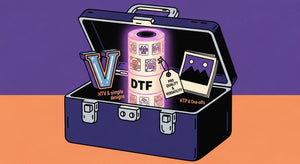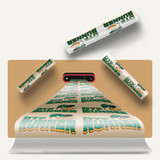Table of Contents
DTF heat transfers are changing the face of customized apparel through vibrant, intricate prints across all kinds of fabrics. Rich results using DTF heat transfers require knowledge of temperature and pressure. This article discusses how these factors impact the DTF transfer process and gives some valuable tips on how to optimize them for the best possible print.
DTF Heat Transfers
DTF heat transfers are achieved by printing designs onto a special film, then the film is applied to fabric using heat and pressure. The result is bright, high-resolution prints that really pop off light and dark fabrics. The quality of the final print is very dependent on proper temperature and pressure settings during the transfer process.
Why Temperature and Pressure Matter in DTF Heat Transfers
Temperature and pressure play critical roles in ensuring that the DTF transfer adheres properly to the fabric. Incorrect settings can lead to issues such as poor adhesion, color distortion, and even damage to the fabric. Now, let us identify why these factors are so important.
The Importance of Temperature
Temperature is essential in activating the adhesive on the DTF film. If the temperature is too low, the adhesive may not fully activate, resulting in poor adhesion and a print that peels or fades quickly. Conversely, if the temperature is too high, it can cause the adhesive to over-activate, leading to color distortion and potential fabric damage.
The Role of Pressure
The pressure ensures the DTF transfer film is in full contact with the fabric. Inadequate pressure will mean that transfers may not bond properly, leading to peeling off or nontransference of parts of the design. However, extreme pressure can cause the ink to bleed and the cloth to scorch at the same time it impacts the quality and durability of the print. The role of pressure is quite important, you should be careful.

Optimal Temperature and Pressure Settings
Finding the optimal temperature and pressure settings for DTF heat transfers involves understanding your equipment and materials. While general guidelines can provide a starting point, it is crucial to test and adjust settings based on your specific setup.
Recommended Temperature Settings
For most DTF heat transfers, a temperature range of 320°F to 350°F (160°C to 175°C) is recommended. However, this can vary depending on the type of fabric and the specific DTF film you are using. Always refer to the manufacturer’s instructions for the best results.
Recommended Pressure Settings
Medium pressure is typically recommended for DTF heat transfers. This usually equates to around 40-60 psi (pounds per square inch) on most heat press machines. Again, the exact pressure may vary depending on the fabric and DTF film, so it’s important to perform test prints to find the optimal setting.
Step-by-Step Guide to DTF Heat Transfers
To achieve the best results with DTF heat transfers, follow these steps:
Prepare Your Design
Make sure that your design is in high resolution, preferably a minimum of 300 DPI. It should be in CMYK color mode to ensure precise replicability of colors. Allow size changes and adjustment in the bleed areas, if need be, so it can fit your transfer film.
Print the Design on DTF Film
Using a DTF printer, print off your design onto the special DTF film. Make doubly sure that the printer settings have been adjusted for the type of film going through it—ink density or print resolution.
Apply Adhesive Powder
After printing, apply adhesive powder to the printed film while the ink is still wet. This powder helps the design adhere to the fabric during the transfer process.
Cure the Film
Cure the adhesive powder by placing the film in a heat press for a few seconds at a lower temperature (around 250°F or 120°C). This step ensures the powder melts and bonds with the ink without fully activating the adhesive.
Position the Film on the Fabric
Place the DTF film with the printed side down onto the fabric. Ensure it is positioned accurately to avoid any misalignment.
Apply Heat and Pressure
Set your heat press to the recommended temperature and pressure settings. Close the press and apply heat and pressure for the specified time (usually 15-20 seconds). Use a Teflon sheet or parchment paper over the film to protect it.
Peel the Film
First, allow it to cool a bit, then carefully peel the film off the fabric. Depending on the type of film, it will either be a hot or cold peel. Again, refer to the instructions for the DTF film type used.
Cure the Print
To ensure the print is fully set and durable, press the garment again for a few seconds with a Teflon sheet on top. This step helps to fully cure the print and enhance its longevity.
Tips for Achieving Optimal Results
Achieving the best results with DTF heat transfers requires attention to detail and some practice. Here are additional tips to help you get the most out of your DTF heat transfers:
Test Prints
Always make test prints on similar fabrics to make sure your settings are correct. Testing allows one to identify and fix problems before moving on to the final print, thereby saving time and materials. This is a time-consuming but effective step.
Consistent Pressure
Ensure the pressure applied is consistent across the entire design to avoid uneven prints. Uneven pressure can cause parts of the design to not adhere properly.
Proper Storage
Keep your DTF transfers in a cool, dry place. This will help the adhesives stay intact. Heat and moisture have a negative effect on the adhesive, which can cause bad results.
Maintenance
Regularly clean your heat press and ensure it is in good working condition. Proper maintenance extends the life of your equipment and ensures consistent results.
Troubleshooting Common Issues
Even with careful preparation, you may encounter some issues with DTF heat transfers. Here are some common problems and how to resolve them:
Print Not Adhering Properly
If the print is not adhering properly, check the heat press temperature and pressure settings. Ensure the fabric is clean and free from contaminants. Adjust the temperature or pressure if needed, and ensure you are applying heat for the recommended time.

Colors Not Vibrant
With very bright colors, you want to make sure you have created your application with the best quality DTF film and that you use inks in good condition. Make sure that you have designed the work in CMYK mode and double-check your heat press settings. Small adjustments in temperature, and slight pressure, can also bring vibrancy back into the color.
Print Cracking or Peeling
If the print is cracking or peeling, ensure the fabric is compatible with DTF transfers and that the print is properly cured. Re-pressing the garment with a Teflon sheet can help set the print better. If issues persist, review your heat press settings and the quality of your DTF materials.
Print Distortion
If it looks distorted after the transfer, it might depict high pressure or temperature. Ensure that the heat press is set in accordance with the recommendation, having equal pressure.
Ink Bleeding
Ink bleeding can occur if too much pressure is applied or if the temperature is too high. Ensure the heat press settings are within the recommended range and that the pressure is adjusted correctly.
In a nutshell, temperature and pressure are equally chief parameters in the making of quality and durable prints of DTF heat transfers. Proper tuning of the settings, roundly combined with the best practices, gives designs that are vibrant while, at the same time, long-lasting. Always test print and adjust these settings according to your particular equipment and materials. The more you really realize how detail-oriented everything has to be, the more you will start to master the art of DTF heat transfers in creating custom apparel that stands out.
Basically, following these guidelines for DTF heat transfers will realize the effectiveness of vibrant and detailed prints. This can produce really long-lasting and eye-catching designs on execution that show quality work. We wish you the best of luck. Happy Printing!






